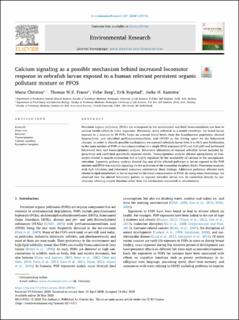| dc.contributor.author | Christou, Maria | |
| dc.contributor.author | Fraser, Thomas William Kenneth | |
| dc.contributor.author | Berg, Vidar | |
| dc.contributor.author | Ropstad, Erik | |
| dc.contributor.author | Kamstra, Jorke Harmen | |
| dc.date.accessioned | 2020-07-09T08:19:26Z | |
| dc.date.available | 2020-07-09T08:19:26Z | |
| dc.date.created | 2020-06-19T13:43:52Z | |
| dc.date.issued | 2020 | |
| dc.identifier.citation | Environmental Research, 2020, Volume 187, 109702 | en_US |
| dc.identifier.issn | 0013-9351 | |
| dc.identifier.uri | https://hdl.handle.net/11250/2661543 | |
| dc.description.abstract | Persistent organic pollutants (POPs) are widespread in the environment and their bioaccumulation can lead to adverse health effects in many organisms. Previously, using zebrafish as a model vertebrate, we found larvae exposed to a mixture of 29 POPs based on average blood levels from the Scandinavian population showed hyperactivity, and identified perfluorooctanesulfonic acid (PFOS) as the driving agent for the behavioral changes. In order to identify possible mechanisms, we exposed zebrafish larvae from 6 to 96 h post fertilization to the same mixture of POPs in two concentrations or a single PFOS exposure (0.55 and 3.83 μM) and performed behavioral tests and transcriptomics analysis. Behavioral alterations of exposed zebrafish larvae included hyperactivity and confirmed previously reported results. Transcriptomics analysis showed upregulation of transcripts related to muscle contraction that is highly regulated by the availability of calcium in the sarcoplasmic reticulum. Ingenuity pathway analysis showed that one of the affected pathways in larvae exposed to the POP mixture and PFOS was calcium signaling via the activation of the ryanodine receptors (RyR). Functional analyses with RyR inhibitors and behavioral outcomes substantiate these findings. Additional pathways affected were related to lipid metabolism in larvae exposed to the lower concentration of PFOS. By using omics technology, we observed that the altered behavioral pattern in exposed zebrafish larvae may be controlled directly by mechanisms affecting muscle function rather than via mechanisms connected to neurotoxicity. | en_US |
| dc.language.iso | eng | en_US |
| dc.rights | Attribution-NonCommercial-NoDerivatives 4.0 Internasjonal | * |
| dc.rights.uri | http://creativecommons.org/licenses/by-nc-nd/4.0/deed.no | * |
| dc.title | Calcium signaling as a possible mechanism behind increased locomotor response in zebrafish larvae exposed to a human relevant persistent organic pollutant mixture or PFOS | en_US |
| dc.type | Peer reviewed | en_US |
| dc.type | Journal article | en_US |
| dc.description.version | publishedVersion | en_US |
| dc.source.volume | 187 | en_US |
| dc.source.journal | Environmental Research | en_US |
| dc.identifier.doi | https://doi.org/10.1016/j.envres.2020.109702 | |
| dc.identifier.cristin | 1816347 | |
| cristin.ispublished | true | |
| cristin.fulltext | original | |
| cristin.qualitycode | 2 | |

